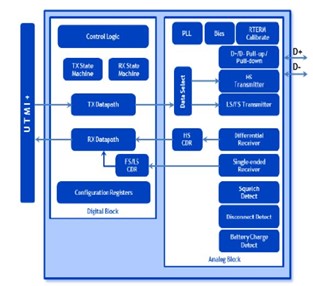The USB2.0 PHY IP is a full physical layer (PHY) IP solution created for exceptional performance and low power consumption. The High-Speed USB 2.0 transceiver, which can be used with hosts, devices, or OTG function controllers, is implemented by the USB2.0 IP. The UTMI+ level 3 specification is followed by the USB2.0 PHY IP, which supports both Full-Speed (12 Mbps) and Low-Speed (1.5 Mbps) data rates. Combining numerous mixed-signal circuits can provide high-speed data transmission at 480Mbps. The USB2.0 PHY IP also supports the expanded USB Battery Charging standards, which are intended for mobile and consumer product applications. The USB 2.0 PHY IP standard is implemented by numerous factories and nodes, including "TSMC 28HPC+, TSMC 40LP, TSMC 40LL, UMC 28HPC, UMC 40LP, UMC 55SP, UMC 55EF, SMIC 14SF+, SMIC 40LL, SMIC 55LL."The USB2.0 PHY IP transceiver's small chip size and low power consumption had no impact on performance or data throughput. In order to completely allow host and device functionality, the USB2.0 PHY IP provides a full on-chip physical transceiver solution with Electrostatic Discharge (ESD) protection, a clock generating block provided by an internal PLL, and a resistor termination calibration circuit.

Compliant with USB2.0 and USB1.1 specification
Compliant with UTMI Specification Version level 3.
Supports HS(480Mbps)/FS(12Mbps) /LS(1.5Mbps) modes
All required terminations, including 1.5Kohm pullup on DP and DM, and 15Kohm pull-down on DP and DM are internal to chip
16-bit, 30MHz or 8-bit, 60MHz parallel interface for HS/FS
Serializing for transmitting data stream and Deserializing for receiving data stream
USB Data Recovery and Clock Recovery on receiving
Integrated Bit Stuffing and NRZI encoding for Transmit
Integrated Bit Un-Stuffing and NRZI decoding for Receive
SYNC and EOP generation on transmit packets and detection on receive packets
Internal reference resistor that replaces the external reference resistor
Built in self test for production testing
Supports USB suspend state and remote wakeup
Supports detection of USB reset, suspend and resume signaling
Supports high speed identification and detection as defined by USB 2.0 Specification
Support high speed host disconnection detection
Silicon Proven in TSMC 28nm, TSMC 40nm, UMC 28nm, UMC 40nm, UMC 55nm, SMIC 14nm, SMIC 40nm, SMIC 55nm
Silicon Proven in TSMC 7FF.
Deliverables
Graphic Data System II File with Layer Configuration
Layout Exchange Format for Placement and Routing Visualization
.lib File Containing Timing, Power, and Noise Characteristics
Verilog Model Describing Functional Circuit Operations
Standard Delay Format (SDF) Timing Applied to Circuit Netlist
Application Notes Providing Insights into Layout Optimization
LVS and DRC Verification Results Documentation